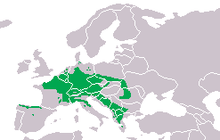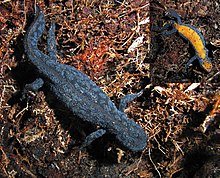Mountain newt
| Mountain newt | ||||||||||||
|---|---|---|---|---|---|---|---|---|---|---|---|---|

Mountain newt ( Ichthyosaura alpestris ), |
||||||||||||
| Systematics | ||||||||||||
|
||||||||||||
| Scientific name of the genus | ||||||||||||
| Ichthyosaura | ||||||||||||
| Latreille in Sonnini de Manoncourt & Latreille, 1801 | ||||||||||||
| Scientific name of the species | ||||||||||||
| Ichthyosaura alpestris | ||||||||||||
| ( Laurenti , 1768) |
The mountain newt or alpine newt ( Ichthyosaura alpestris , syn .: Triturus alpestris , at times also Mesotriton alpestris , cf.: Triturus ) belongs to the amphibian order of the tailed amphibian . The species is common in parts of Europe. The mountain newch was named " Lurch of the Year 2019 ".
features
During the mating season in spring, the up to nine centimeters long males have a blue back color; their flanks are dotted black and white and bordered by a blue stripe towards the belly. The flat, straight (not serrated) back ridge is alternately yellowish-black spotted. The up to twelve centimeters long females are marbled dark gray-brown-greenish in water and show a slightly weaker flank dots. The central ventral side of both sexes is bright orange to vermilion and - in contrast to other newt species - usually unspotted. After the end of the spawning season in May, the adult animals leave the water and gradually develop a more inconspicuous land costume . This is characterized by a dark, almost black, granulated, dull and water-repellent skin on the top. The belly still remains a bit orange, but is less intense in color than in the water dressing.
Habitat, way of life and occurrence
The mountain newt is a typical inhabitant of water-rich forests in hilly to mountainous landscapes - it is often associated with the filamentous newt, which is less common overall. It is mostly absent in areas with little forest. In addition to dense deciduous forests, park-like areas and natural gardens are also populated. The mountain newt is a nocturnal land animal outside the spawning season. During the day he hides in all sorts of shady hiding spots, for example under stones or wood. At night he goes hunting for beetles, earthworms and other small animals. Its main enemies include trout , other fish and larvae of the blue-green mosaic maiden , which mainly prey on the newt larvae. After "awakening" from the frozen state in February / March, mountain newts immediately migrate to bodies of water in the vicinity - especially forest ponds and lakes, extinguishing ponds, wild valleys and water-filled wagon tracks on forest roads. These can also be cool, shady and without vegetation. (For courtship and mating behavior in water: compare pond newt , triturus or northern crested newt .) A female can produce up to 250 eggs in one season. It attaches these individually to aquatic plants or fallen leaves by folding a "pocket" into the leaves with its hind legs. Depending on the water temperature, embryonic development takes two to four weeks.
The older larvae, finally 50 (sometimes 80) millimeters long, can be distinguished from other newt larvae by a blunt tail end with a thorn. In addition, the larvae are often very darkly pigmented (reticulated). After about four to five months of “predatory” life in the water, they reach metamorphosis . In contrast to the tadpoles of the frogfish, older newt larvae feed exclusively on animal prey (e.g. water fleas , water lice , river flea shrimp ), sometimes also from their own kind ( cannibalism ). In the first phase of life, however, tiny algae are eaten. Mountain newt larvae in particular live mainly benthically , i.e. H. close to the bottom of the water. They regularly overwinter in the water and do not transform until the following year; at least this is described for populations in larger and deeper waters that do not completely freeze over. The phenomenon of neoteny (also: pedomorphism), i.e. the permanent persistence of larval features despite sexual maturity, occurs relatively often in mountain newts in particular.
- Egg laying and larval development
A hatching embryo
distribution
The distribution of the various subspecies of the mountain newt ranges from northern France across parts of central Europe and northern Italy to northern Greece. In Southeastern Europe, larger mountain ranges in particular are populated, including the Carpathian and Dinaric Mountains . There are also disjoint occurrence areas in the south of Denmark and in the north of the Iberian Peninsula . In Germany, the mountain newt occurs more or less closed in the central and southern part. In the north-west German lowlands there are only island-like occurrences in the area of historically old deciduous forest areas. The lowest-lying evidence can also be found there - sometimes only five meters above sea level. The species is absent in north-east Germany. The main focus of the distribution is the wooded hills and mountains. In the Alpine region, the species occurs in Switzerland up to 2500 meters above sea level .
Systematics and nomenclature
Until they were split up in recent years, the mountain newt was included in the genus Triturus . This taxon , which contains up to 16 species, is paraphyletic according to the current view and should therefore be resolved. The traditional name Triturus alpestris is still sometimes used; now, however, a monotypical genus is required for the mountain newt. According to the priority rule in the taxonomic nomenclature, the designation Ichthyosaura (literally: "fish lizard") as the oldest genus name that clearly relates to the species has priority. This was given in 1801 by the author Latreille for a newt larva which, according to today's interpretation, suggests an assignment to a mountain newt. The name Mesotriton alpestris , which was revalidated in 2004 and has been increasingly used since then, would no longer be valid, as it was coined in 1928. However, the validity of the name Ichthyosaura alpestris is not currently recognized by all authors; they still prefer Mesotriton alpestris .
Numerous subspecies have been described within the distribution area , some of which only occur in pedomorphic ( neotene ) stages and whose validity is questioned in several cases:
- Ichthyosaura alpestris alpestris ( nominate form ; Central, Western and Eastern Europe; in the south to the northern Balkans )
- I. alpestris apuana (parts of France and Italy)
- I. alpestris cyreni (Northwest and Central Spain )
- I. alpestris inexpectata (southern Italy)
- I. alpestris lacusnigri (western Balkans; including Slovenia )
- I. alpestris montenegrina (neotene form; status disputed; in Montenegro )
- I. alpestris piperiana (neotene form; status disputed; in Montenegro)
- I. alpestris reiseri (partly neotene form; status disputed; in Bosnia )
- I. alpestris serdara (neotene form; in Montenegro)
- I. alpestris veluchiensis (central Greece)
In 2013, an extinct close relative of the mountain newt living in the Miocene was described. A complete, well-preserved fossil of Ichthyosaura randeckensis was found in the Randecker Maar , a former volcanic vent on the edge of the Swabian Alb .
Hazard and protection
Mountain newt populations suffer from the destruction or impairment of small bodies of water through the filling or the entry of garbage, fertilizer and other environmental toxins as well as the filling of previously unpaved forest roads with rubble. If fish are used in small bodies of water that would not naturally occur there, this usually leads to a collapse of the newt population, since most fish eat spawn and larvae.
During the seasonal migrations, for example from winter quarters to spawning waters, mountain newts and other amphibians have high losses from road traffic in many places in densely populated Central Europe.
Like all amphibians native to Europe, mountain newts and their stages of development must not be caught, but must be left in their natural habitat. Suitable protective measures for newts are in particular the creation of small bodies of water and their regular maintenance (weed removal).
Legal protection status (selection)
- Habitats Directive : not listed
- Federal Nature Conservation Act (BNatSchG): particularly protected
National Red List classifications (selection)
- Red list of the Federal Republic of Germany: not endangered
- (in individual Red Lists of the federal states, however, classification in different hazard categories)
- Red list of Austria: NT (endangerment threat; warning list)
- Red list of Switzerland: LC (not endangered)
literature
- Andreas Nöllert, Christel Nöllert: The amphibians of Europe. Franckh-Kosmos, Stuttgart 1992, ISBN 3-440-06340-2 .
- Burkhard Thiesmeier, Ulrich Schulte: The mountain newt - at home in the lowlands as well as in the high mountains. Supplement to the Zeitschrift für Feldherpetologie. 13 (2010), Laurenti-Verlag, Bielefeld, ISBN 978-3-933066-42-8 .
Web links
- Mountain newch on the IUCN Red List of Threatened Species .
- Some photos of mountain newts and their larvae at www.herp.it
- The Bergmolch - Lurch of the year 2019 . In: Sachsen-Anhalt-Journal 2019
Individual evidence
- ^ Nöllert, Nöllert: The amphibians of Europe. 1992, p. 195.
- ^ Nöllert, Nöllert: The amphibians of Europe. 1992, p. 106.
- ↑ Thiesmer, Schulte: Der Bergmolch. 2010, p. 104.
- ↑ Bjergsalamander ( Ichthyosaura alpestris ) at Danmarks Fugle og Natur ; online: [1]
- ↑ Josef F. Schmidtler: The roots of a Bavarian herpetofaunistics in the 18th and early 19th century. In: Journal of Field Herpetology. 14 (2007). Laurenti-Verlag, Bielefeld, ISSN 0946-7998 , pp. 93-119. ( Article as PDF online; see in particular p. 105 )
- ↑ Josef F. Schmidtler: Ichthyosaura, the new generic name for the mountain newt - a teaching example in terms of nomenclature. In: Journal of Field Herpetology. 16 (2009), Laurenti-Verlag, Bielefeld, ISSN 0946-7998 , pp. 245-250. ( Article as PDF online )
- ↑ see for example: Red list of amphibians in North Rhine-Westphalia, as of September 2011 ( PDF online )
- ^ Rainer R. Schoch & Michael W. Rasser: A new salamandrid from the Miocene Randeck Maar, Germany. Journal of Vertebrate Paleontology 33 (1): page 58-66, doi: 10.1080 / 02724634.2012.716113
- ↑ Bergmolch at www.wisia.de
- ↑ Online overview at www.amphibienschutz.de












